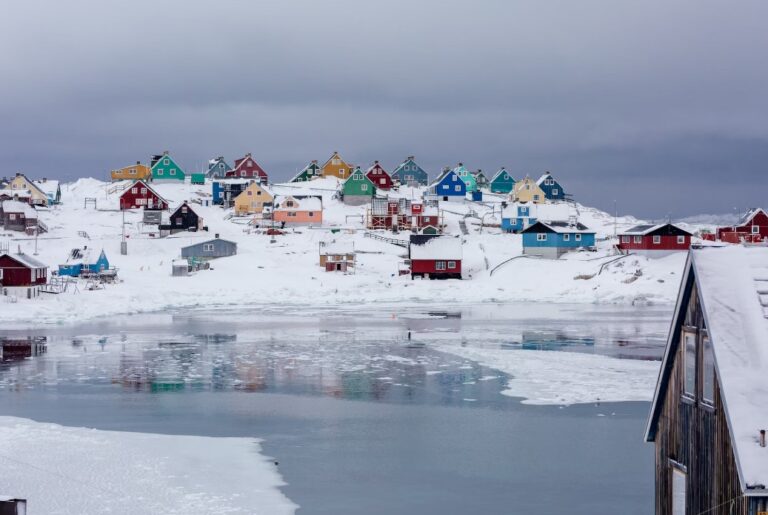In a world that is characterized by both busy cities and densely populated regions, there are huge stretches that are characterized by the dominance of isolation and the scarce presence of human settlement.
Compared to the urban sprawl that characterizes a significant portion of the modern globe, these regions, which are distinguished by their low population density, provide a striking contrast.
In this article, we’ll explore six of the least densely populated areas in the world, each possessing its own unique landscape and contributing to the preservation of natural beauty.
Table of Contents
The 6 least densely populated areas
1. Greenland
With only 0.03 people per square kilometer, Greenland is one of the least densely populated areas internationally, but it is well-known for its huge ice sheets and Arctic scenery. A large, self-governing region inside the Danish Kingdom, it has been inhabited for more than four thousand five hundred years.
Since the majority of Greenland is encased in ice, the majority of its inhabitants call the rocky coast on the west coast home. Icebergs, glaciers, and hardy humans all call this beautiful but tough island home. The island’s low population density is probably a result of the severe environment.
Because of its small population (around 56,000 people), Greenland is the best place to go if you are looking for a place to escape from civilization.
2. Mongolia
Mongolia is located in central Asia and is characterized by vast steppes and the persistence of nomadic traditions. Genghis Khan is its most famous resident, yet just 2.04 individuals call each square km of this massive country home.
The enormous Mongolian landscape is mostly unpopulated due to the country’s extremely low population density. Reasons for the low population density include the difficulties of occupying much of the land and the fact that it is surrounded by both Russia and China.
Ulaanbaatar, Mongolia’s capital, has the coldest winters on record, with an average temperature of -1.3 degrees Celsius. Offering a one-of-a-kind combination of cultural diversity and breathtaking natural scenery, Mongolia is characterized by its nomadic herders and gers scattered over the terrain.
3. Namibia
The low population density and dry terrain of Namibia, a country in southern Africa, are its defining characteristics. There are 2.97 people per square kilometre, according to the most recent census. The country is somewhat high altitude, therefore it stays rather temperate even though its landscape is primarily desert and dune-like.
One of the world’s oldest deserts, the Namib Desert, covers most of the landscape. Because of its dispersed population, Namibia is able to maintain the delicate balance of its distinct ecosystems by leaving large areas of desert wilderness undeveloped.
Only at Warmbad, in the south of the country, do the weather conditions correspond to the topography. While less prevalent than in nations farther north in the Sub-Saharan region, droughts still occur frequently in the country.
4. Australia
In spite of its many ecosystems, the continent of Australia has some of the world’s least heavily populated regions. On an island that measures 7.69 million square kilometres, the population density is 3.25, with over 25,604,700 people calling it home.
There are fewer people living in the dry, sparsely populated Australian Outback compared to the more populous coastal areas. Despite the rain forests and mountain ranges that cover other parts of the country, the continent is the driest, flattest, most barren, and least favourable to organic growth due to the abandoned Outback.
The Outback is a symbol of the fortitude of the Australian people and the enormous size of the continent; it is also a place of great isolation and difficulty.
5. Iceland
Iceland, which is located in the North Atlantic Ocean, is a mesmerizing location due to its otherworldly scenery and low human density. There are around 362,860 people living in this region, the majority of whom reside in the capital region of Reykjavík, where more than 63% of the population resides.
People who are looking for isolation in the midst of nature’s majesty will find the island to be a haven thanks to its volcanic wonders, geysers, and glaciers, which contribute to the island’s particular charm. Iceland is currently seeing a robust population increase that is comparable to that of other European countries.
6. Canada
As the world’s second-largest country, Canada is home to huge wilderness regions that are characterized by a population density that is insignificant in relation to the country’s enormous size.
Known for its tundra, boreal forests, and Arctic vistas, the northern regions of Yukon, Northwest regions, and Nunavut are exceptional examples of the Canadian wilderness.
People who are looking for seclusion in the middle of the magnificence of the wilderness will find Canada to be a haven because of its small population, which allows for the preservation of natural habitats that are in their purest form.
Preserving the earth’s captivating and untouched areas
By serving as reminders of the world’s vast and varied landscapes, these six localities with the lowest population density serve as examples of places where solitude and the splendor of nature are the norm.
These locations, whether they are located in the cold expanses of Greenland, the nomadic tranquilly of Mongolia, or the arid elegance of Namibia, all contribute to the preservation of the most compelling and unexplored corners of the Earth.
Read also: The 6 most secret and still uncontacted tribes in the world in 2023












